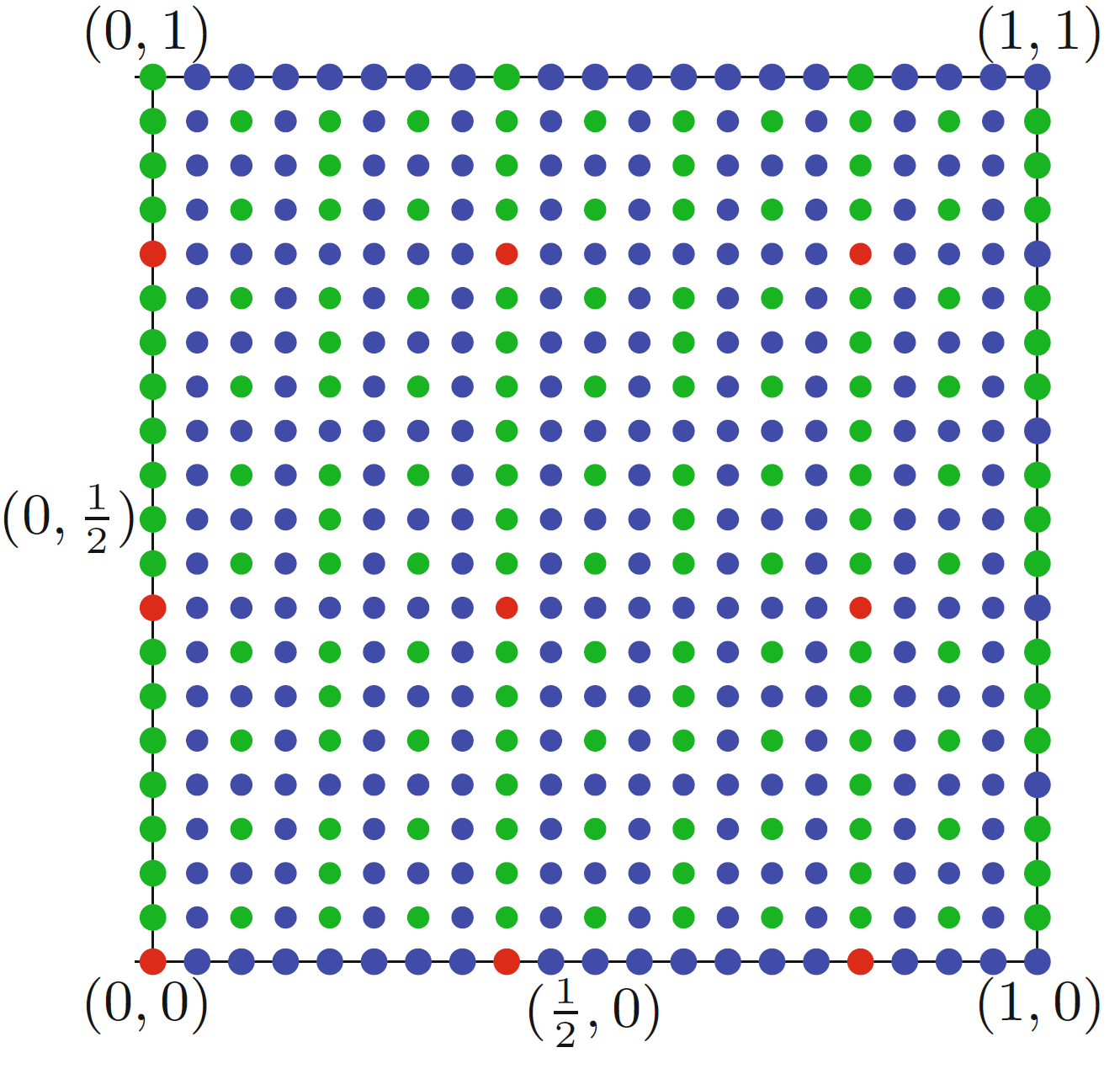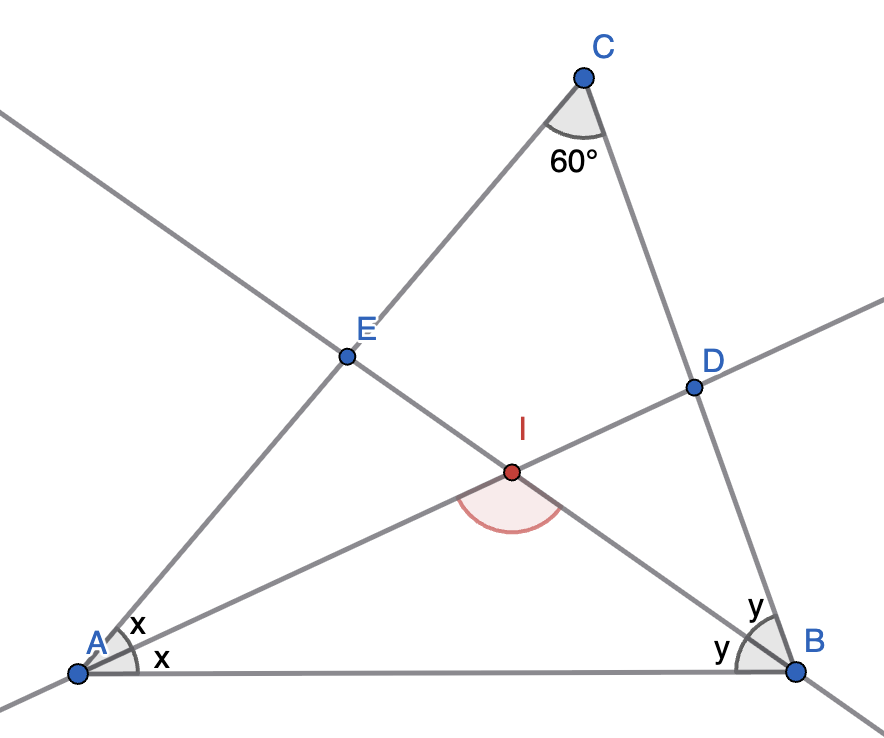Problems
Are there any two-digit numbers which are the product of their digits?
The sum of Matt’s and Parker’s ages is \(63\) years. Matt is twice as old as Parker was when Matt was as old as Parker is now. How old are they? (Show that there’s no other ages that they could have)
How many \(10\)-digit numbers are there such that the sum of their digits is \(3\)?
We want to prove Monsky’s theorem as a corollary of Sperner’s lemma:
it is not possible to dissect a square into an odd number of triangles
of equal area. After scaling we can consider the square with
coordinates: \((0,0),(0,1),(1,0),(1,1)\), which we want to
cut into \(n\) triangles with area
\(\frac{1}{n}\) each for an odd \(n\). Consider the following coloring of all
the points with rational coordinates \((\frac{p}{q},\frac{r}{s})\) inside the
square:
We look at the powers of \(2\) in the
fractions \((\frac{p}{q},\frac{r}{s})\), first of all
the numbers \(p,q\) are coprime, and
thus only one of them is divisible by \(2\), same with \(r,s\). Then the following possibilities
might occur:
Neither \(q\) nor \(s\) is divisible by \(2\). In this case we color the point red.
\(\frac{r}{s}\) is divisible by a larger or equal power of \(2\) than \(\frac{p}{q}\) and \(p\) is not divisible by \(2\). In this case we color the point blue.
\(\frac{p}{q}\) is divisible by a strictly larger power of \(2\) than \(\frac{r}{s}\) and \(r\) is not divisible by \(2\). In this case we color the point green.

Under an assumption (which you do not have to prove) that the area of any rainbow triangle is at least \(\frac{1}{2}\) prove the Monsky’s theorem.
The sum of digits of a positive integer \(n\) is the same as the number of digits of \(n\). What are the possible products of the digits of \(n\)?
In the triangle \(\triangle ABC\), the angle \(\angle ACB=60^{\circ}\), marked at the top. The angle bisectors \(AD\) and \(BE\) intersect at the point \(I\).
Find the angle \(\angle AIB\), marked in red.

Find, with proof, all integer solutions of \(a^3+b^3=9\).
Prove the general version of Sperner’s lemma: Consider an \(n\)-dimensional simplex \(\mathcal{A} = A_1A_2...A_{n+1}\). Strictly speaking a simplex is a convex linear combination of \(n+1\) points in general position (when \(k\) points are never in one subspace of dimension \(k-1\)). One can view it as an \(n\)-dimensional tetrahedron or a body spanned over vertices \((0,0,...,0), (1,0,0,...,0), (0,1,0,0...,0), ... (0,0,...0,1)\). \[\mathcal{A} = \{\sum_{i=1}^{n+1}a_i(0,0,...,1,...,0), \,\,\, a_i \geq 0, \,\,\,\, \sum_{i=1}^{n+1}a_i = 1\}.\]
A simplicial subdivision of an \(n\)-dimensional simplex \(\mathcal{A}\) is a partition of \(\mathcal{A}\) into small simplices (cells)
of the same dimension, such that any two cells are either disjoint, or
they share a full face of a certain dimension.
Define a Sperner’s coloring of a simplicial subdivision as an assignment
of \(n+1\) colors to the vertices of
the subdivision, so that the vertices of \(\mathcal{A}\) receive all different colors,
and points on each face of \(\mathcal{A}\) use only the colors of the
vertices defining the respective face of \(\mathcal{A}\).
Prove that every Sperner’s coloring of any subdivision of an \(n\)-dimensional simplex contains an odd
number of rainbow simplexes, namely whose vertices are colored using all
\(n+1\) colors.
Draw Sperner’s coloring for the following triangulation. Try to avoid rainbow triangles at all costs.

Consider an \(n\)-dimensional simplex \(\mathcal{A} = A_1A_2...A_{n+1}\), namely a body spanned over vertices \((0,0,...,0), (1,0,0,...,0), (0,1,0,0...,0), ... (0,0,...0,1)\). \[\mathcal{A} = \{\sum_{i=0}^{n}a_i(0,0,...,1,...,0), \,\,\, a_i \geq 0, \,\,\,\, \sum_{i=1}^{n+1}a_i = 1\}.\] Where next to \(a_i\) there is a point with coordinate where \(1\) is in \(i\)-th place. The point \((0,0,...,0)\) belongs to the simplex as well.
A simplicial subdivision of an \(n\)-dimensional simplex \(\mathcal{A}\) is a partition of \(\mathcal{A}\) into small simplices (cells)
of the same dimension, such that any two cells are either disjoint, or
they share a full face of a certain dimension.
Define a Sperner’s coloring of a simplicial subdivision as an assignment
of \(n+1\) colors to the vertices of
the subdivision, so that the vertices of \(\mathcal{A}\) receive all different colors,
and points on each face of \(\mathcal{A}\) use only the colors of the
vertices defining the respective face of \(\mathcal{A}\).
Consider a simplicial subdivision given by pairwise connected middles of
all the segments in the original simplex. Assign the numbers \(0,1,2...,n\) to the subdivision vertices in
such a way as to conduct a Sperner’s coloring in such a way that you
will have only one rainbow simplex.